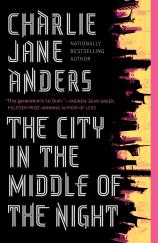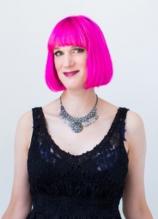The City in the Middle of the Night
Review
The City in the Middle of the Night
When the advance word on a fantasy novel compares it to Ursula K. Le Guin or Philip Pullman or Frank Herbert --- all master builders of rich, strange worlds --- I’m intrigued but also suspicious: truth or hype? Not that Charlie Jane Anders needs the buzz. Former editor-in-chief of io9, the sci-fi/fantasy blog, she won a Hugo Award for her novelette, “Six Months, Three Days,” in 2012, and the 2017 Nebula Award for her first novel, ALL THE BIRDS IN THE SKY.
THE CITY IN THE MIDDLE OF THE NIGHT, her new book, puts the science in science fiction with a fascinating premise. The setting is January, a barely habitable “tidally locked” planet. One side always faces its star, while the other remains in perpetual darkness (the moon in our own solar system is an example); thus, it is subject to extremes of brightness and gloom, heat and cold. Pitting humans against a hostile environment, Anders constructs a society that’s lavishly detailed and wonderfully convincing.
The story of the planet’s settlement emerges little by little. Generations ago, when Earth’s surface became too contaminated to support life, seven city-states collaborated on an escape vehicle, the Mothership. The fire-and-ice climate on January meant that colonists could survive only in a very limited temperate zone, and their arrival disrupted the world’s fragile ecological balance. Now, troubling developments --- toxic rain, stunted infant development, machine breakdown, shortages of food and water --- suggest imminent collapse.
Most of the human population lives in two main cities, a study in contrasts. Authoritarian, class-divided Xiosphant deals with the absence of day and night by imposing strict Timefulness on its citizens: Everyone must wake and sleep at the same hour. In Argelo, there is no official circadian rhythm; everyone rests or rouses, works or plays, whenever they like. It’s free, but it’s violent and chaotic --- and run by crime families. Anders also creates a marvelous indigenous species, the Gelet. Although disturbingly creepy in appearance (fur, tentacles, pincers), and thus feared and demonized by humans, these aliens possess genius-level intelligence and a highly sophisticated culture and technology.
"THE CITY IN THE MIDDLE OF THE NIGHT...puts the science in science fiction with a fascinating premise.... Pitting humans against a hostile environment, Anders constructs a society that’s lavishly detailed and wonderfully convincing."
Paralleling the two distinctive cities are two pairs of protagonists, neither of them the conventional boy/girl arrangement. The lovers, seekers and action heroes in Anders’ novel are all women. That’s refreshing.
Bianca and Sophie are roommates, or something more, at the Xiosphanti equivalent of college, the Gymnasium. Bianca, one of the city’s social-political elites, is worshipped by Sophie, who’s from the darker side of town, where people have trades rather than careers; she has barely escaped the ominous-sounding “marriage requirement.” The other duo consists of Alyssa and the oddly named Mouth, “sleepmates” who are members of a ruthless band of itinerant traders/smugglers/bandits. Alyssa is a tough urban lass from Argelo; Mouth, the lone survivor of a defunct nomadic tribe called the Citizens.
It isn’t long before the two couples’ trajectories converge. Unwise dabbling in radical student politics gets Sophie arrested and cast into the icy darkness outside Xiosphant. It’s there that she meets one of the Gelet, communicating with the creature through a sort of mind-meld (if I may borrow a term from Mr. Spock). Alyssa and Mouth, meanwhile, have run into problems with a delivery of goods and must take up temporary residence in Xiosphant. Mouth, a wanderer from birth, feels ill at ease: “In a city, you could only walk in circles. Trouble knew where to find you. People lived with more things than they could carry, and they pretended that built structures were geographical features.” Yet she is pragmatic enough to use this opportunity to explore the mystery of her forbears’ premature demise.
A ton of action ensues. The plot verges on the space-operatic, involving battles with pirates, extraterrestrial bison and giant squid, plus typhoons, icebergs and a body of water known as the Sea of Murder. Coincidences and lucky interventions abound. I could hear the plot wheels creak when, for example, Sophie, on the run, finds refuge in an exotic therapy-center-cum-alternative-space known as the Illyrian Parlour; or when Mouth comes across a professor who (conveniently) specializes in the study of the Citizens. It’s understandable, given the ambitious scope of the book, that the story line doesn’t always flow organically. In a pre-publication blog entry, Anders described the work-in-progress as “a sprawling mess…. The worldbuilding was huge but the characters and their journey weren’t coming together the way I wanted.”
I hate to use her own words against her, but to me, the characters still don’t quite jell. Alyssa (street kid with a heart of gold) and Bianca (prom queen with a lust for power) tend toward “types” who don’t evolve much. The other two are more capable of self-transformation, yet they, too, cling to a semi-adolescent mindset. Mouth wrestles interminably with her cryptic past and elusive identity; while Sophie, apparently blind to Bianca’s turpitude, continues to long for her, in lovestruck passages that seem straight out of a Twilight-style YA romance.
To my mind, of all Anders’ creations, the alien species, the Gelet, is the most remarkable, and perhaps the most adult. She doesn’t idealize them, doesn’t make them cute and appealing. Human reactions range from Bianca’s revulsion (she calls them monsters) to Mouth’s uneasy awareness of “segmented bodies” and “wormy flesh” to Sophie’s gradual acceptance and affection. Although Sophie thinks of them as female and even assigns them names, the Gelet aren’t an assemblage of individuals but rather a sort of telepathic group mind. From Rose, her first contact, Sophie learns their origin story, how they discovered that “to join with others to shape a future is the holiest act.… [T]his collective dreaming/designing is the only way we get to keep surviving, and this practice defines us as a community.”
Ultimately, Sophie finds the courage to embrace these astonishing beings on a deeper, more permanent level, thus changing the way she experiences reality --- and, most likely, altering the destiny of the planet. More than that, I shall not reveal, but I believe the ending of THE CITY IN THE MIDDLE OF THE NIGHT leaves the way open to a sequel. And that’s a good thing. Such a dazzling fantasy world shouldn’t vanish after only one book.
Reviewed by Katherine B. Weissman on February 22, 2019
The City in the Middle of the Night
- Publication Date: February 11, 2020
- Genres: Fiction, Science Fiction
- Paperback: 368 pages
- Publisher: Tor Books
- ISBN-10: 076537997X
- ISBN-13: 9780765379979




